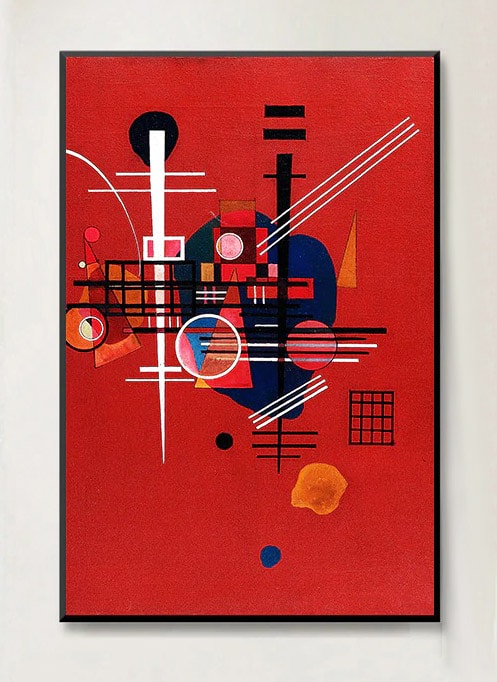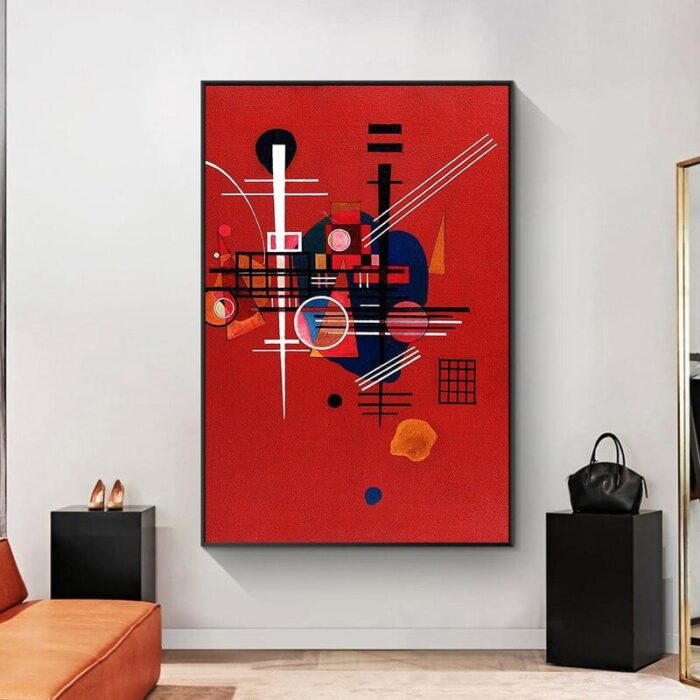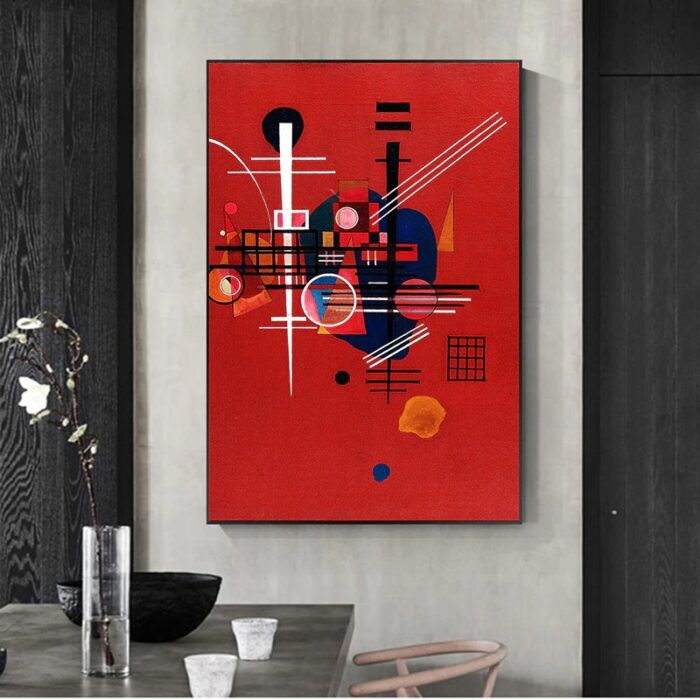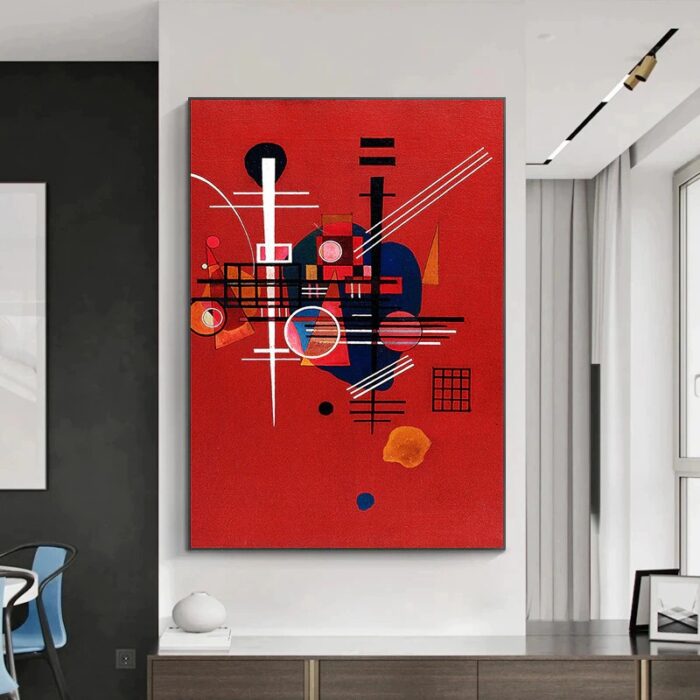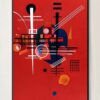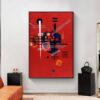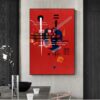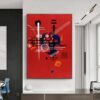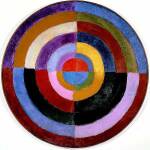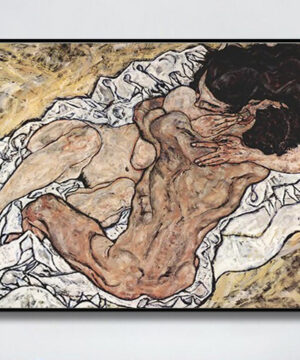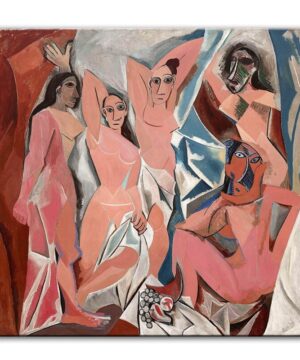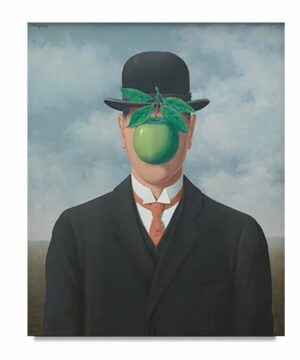Russian painter and art theorist Wassily Kandinsky is credited as the pioneer of abstract modern art. His notion that only total abstraction could offer profound and transcendental expression had a strong impact on the international development of abstraction. Contrary he believed copying from nature would interfere with this process. Kandinsky’s mature pictorial language only loosely related to the outside world, and instead expressed the artist’s inner experience as in “Dull Red No. 400”.
Where is the picture “Dull Red No. 400” today?
The Kandinsky original of the picture “Dull Red No. 400” (“Dumpfes Rot Nr. 400”) is part of the collection of the Dickinson Gallery in London.
What’s in it?
“Dull Red No. 400” exemplifies Kandinsky’s distinctive style he employed while teaching at the BauhausThe Bauhaus movement originated as a German school of the arts in the early 20th century. Founded by German architect Walter Gropius in 1919, the school was dedicated to uniting all branches of the arts under one roof. The Bauhaus acted as a hub for Europe's most experimental creatives, with well-known artist instructors like Wassily Kandinsky, Josef Albers, and Paul More school in Germany, moving away from abstraction in paintingPainting is a fundamental form of visual art that has been practiced for thousands of years. It involves applying pigment to a surface such as canvas, paper, or a wall. Painting can be explored through various styles, techniques, and mediums, each offering unique possibilities for expression and creativity. Historical Background • Ancient Beginnings: The history of painting dates back to More towards purely geometric composition. Intersecting lines, circles, triangles, half-circles, and dots of different colours, hues, and shadesIn color theory, a shade is a darker version of a color, created by adding black to the original hue. This concept is essential for artists and designers, as it allows for a range of deeper, more intense tones that can add depth and drama to a composition. Defining Shade A shade results from mixing a pure hue with black. More painted with great precision populate the composition against the backdrop of a dark red colour palette. Choosing tonesIn color theory, a tone is a version of a color created by adding gray (a mix of black and white) to the original hue. This concept is essential for artists and designers as it allows for a wide range of colors that are neither too dark nor too light, providing versatility in creating depth, mood, and harmony within a More of blue, orange, black, and white, Kandinsky reaches a perfect balance of the composition solely dominated by form and structure. Kandinsky aimed at bringing out the original force of colour and composition without the distraction of mapping of object effect, capturing the spiritual quality of life represented by the tension of colour and geometric graphic form, as he expressed in his writings.
What’s the context?
Wassily KandinskyWassily (Vasily) Kandinsky (1866 – 1944) is known as one of the pioneers of abstract modern art. He was born in in Moscow to upper-class parents of mixed ethnic origins. At an early age, Kandinsky showed a rare sensitivity towards music and the arts, which his father strongly supported. Kandinsky decided to study law, ethnography, and economics, and started successfully More – BauhausThe Bauhaus movement originated as a German school of the arts in the early 20th century. Founded by German architect Walter Gropius in 1919, the school was dedicated to uniting all branches of the arts under one roof. The Bauhaus acted as a hub for Europe's most experimental creatives, with well-known artist instructors like Wassily Kandinsky, Josef Albers, and Paul More:
1922, Kandinsky had accepted a teaching position at the German Bauhaus, the state-sponsored Weimar school of art and applied design, which had been founded in 1919 by architect Walter Gropius. The BauhausThe Bauhaus movement originated as a German school of the arts in the early 20th century. Founded by German architect Walter Gropius in 1919, the school was dedicated to uniting all branches of the arts under one roof. The Bauhaus acted as a hub for Europe's most experimental creatives, with well-known artist instructors like Wassily Kandinsky, Josef Albers, and Paul More upheld the concept that crafts were to be considered equal to traditional arts and was organized according to a medieval-style guild system training under the guidance of masters. While teaching at the BauhausThe Bauhaus movement originated as a German school of the arts in the early 20th century. Founded by German architect Walter Gropius in 1919, the school was dedicated to uniting all branches of the arts under one roof. The Bauhaus acted as a hub for Europe's most experimental creatives, with well-known artist instructors like Wassily Kandinsky, Josef Albers, and Paul More, Kandinsky synthesized elements from ConstructivismConstructivism is a revolutionary art movement that originated in Russia in the early 20th century, right after the Russian Revolution. It's a term that captures an entirely new approach to art and architecture, distinguished by its devotion to modernity, functionality, and the embrace of technology and industrial materials. Constructivism marks a bold departure from the art for art's sake philosophy, More, Suprematism, and the school’s own ethos, arriving at the flat planes of colour and a linear quality as seen in “Dull Red No. 400”. Kandinsky would consequently rely upon this style to communicate deeper content for the rest of his career. Kandinsky taught at the three locations of the school in Weimar, Dessau, and Berlin until 1933 when the BauhausThe Bauhaus movement originated as a German school of the arts in the early 20th century. Founded by German architect Walter Gropius in 1919, the school was dedicated to uniting all branches of the arts under one roof. The Bauhaus acted as a hub for Europe's most experimental creatives, with well-known artist instructors like Wassily Kandinsky, Josef Albers, and Paul More was forced to close due to pressure from the German Nazi government.
Chatter and Prattle
Wassily KandinskyWassily (Vasily) Kandinsky (1866 – 1944) is known as one of the pioneers of abstract modern art. He was born in in Moscow to upper-class parents of mixed ethnic origins. At an early age, Kandinsky showed a rare sensitivity towards music and the arts, which his father strongly supported. Kandinsky decided to study law, ethnography, and economics, and started successfully More – Facts:
- Kandinsky’s embrace of modernist abstract art
%22%20transform%3D%22translate(.5%20.5)%22%20fill-opacity%3D%22.5%22%3E%3Cellipse%20fill%3D%22%23fff%22%20rx%3D%221%22%20ry%3D%221%22%20transform%3D%22rotate(49.5%20-73.5%20216.4)%20scale(22.32723%2041.18916)%22%2F%3E%3Cellipse%20fill%3D%22%2360313a%22%20cx%3D%2272%22%20cy%3D%2276%22%20rx%3D%2261%22%20ry%3D%2261%22%2F%3E%3Cellipse%20fill%3D%22%23fff%22%20rx%3D%221%22%20ry%3D%221%22%20transform%3D%22rotate(-131.7%2070.2%20-26.1)%20scale(108.88858%2017.91884)%22%2F%3E%3Cellipse%20fill%3D%22%23fff%22%20rx%3D%221%22%20ry%3D%221%22%20transform%3D%22rotate(-131.1%2036.5%2066.6)%20scale(60.55413%2017.0478)%22%2F%3E%3C%2Fg%3E%3C%2Fsvg%3E) Abstract artworks diverge from depicting recognizable scenes or objects and instead use colors, forms, and lines to create compositions that exist independently of visual references from the natural world. This movement, which gained momentum in the early 20th century, was propelled by artists such as Wassily Kandinsky, Piet Mondrian, and Kazimir Malevich. These artists aimed to explore spiritual, emotional, and More landed him a prominent position in the Nazis’ “Degenerate Art” (“Entartete Kunst”) exhibition, which featured 650 works of art deemed anathema to the regime’s totalitarian values. The show included works by numerous artists of international acclaim, including Paul KleePaul Klee (1879-1940) was a Swiss-born painter and graphic artist whose work is associated with expressionism, cubism, and surrealism. Klee's art is characterized by his playful and experimental use of color, line, and form. He produced over 9,000 works, including paintings, drawings, and prints, making significant contributions to modern art. Early Life and Education Born in Münchenbuchsee, Switzerland, Klee showed More, Max Beckmann, Emil Nolde, and Oskar Kokoschka. The exhibition catalogue explained the aim of the show being to “reveal the philosophical, political, racial and moral goals and intentions behind this movement and the driving forces of corruption which follow them.”
Abstract artworks diverge from depicting recognizable scenes or objects and instead use colors, forms, and lines to create compositions that exist independently of visual references from the natural world. This movement, which gained momentum in the early 20th century, was propelled by artists such as Wassily Kandinsky, Piet Mondrian, and Kazimir Malevich. These artists aimed to explore spiritual, emotional, and More landed him a prominent position in the Nazis’ “Degenerate Art” (“Entartete Kunst”) exhibition, which featured 650 works of art deemed anathema to the regime’s totalitarian values. The show included works by numerous artists of international acclaim, including Paul KleePaul Klee (1879-1940) was a Swiss-born painter and graphic artist whose work is associated with expressionism, cubism, and surrealism. Klee's art is characterized by his playful and experimental use of color, line, and form. He produced over 9,000 works, including paintings, drawings, and prints, making significant contributions to modern art. Early Life and Education Born in Münchenbuchsee, Switzerland, Klee showed More, Max Beckmann, Emil Nolde, and Oskar Kokoschka. The exhibition catalogue explained the aim of the show being to “reveal the philosophical, political, racial and moral goals and intentions behind this movement and the driving forces of corruption which follow them.” - The German Nazis claimed that degenerate art was the product of Bolsheviks and Jews, even if only six of the 112 artists featured in the show were Jewish.
- One exhibition hall featured entirely abstract paintings, among them Kandinsky’s paintings, and was labelled the “Insanity Room”.
Do you want to comment on this text or add information? We would like to hear from you.
Read our Post on Kandinsky’s Color TheoryColor Theory is a comprehensive framework used to understand and analyze the use and interaction of colors in visual compositions. It serves as a critical guide for artists, designers, and marketers, helping them create harmonious and effective designs. This concept encompasses various principles and elements that dictate how colors are combined, perceived, and utilized. Primary Colors: • The three foundational More:
Mastering Art with Color Theory: Kandinsky’s Transformative Vision
Recommended Reading:
This article may contain compensated links. Please read Disclaimer for more info. As an Amazon Associate, I earn from qualifying purchases.
Michael Kerrigan (2015): Wassily Kandinsky Masterpieces of Art
Helmut Friedel et al. (2016): Vasily Kandinsky
Wassily KandinskyWassily (Vasily) Kandinsky (1866 – 1944) is known as one of the pioneers of abstract modern art. He was born in in Moscow to upper-class parents of mixed ethnic origins. At an early age, Kandinsky showed a rare sensitivity towards music and the arts, which his father strongly supported. Kandinsky decided to study law, ethnography, and economics, and started successfully More (2019): Sounds
Wassily KandinskyWassily (Vasily) Kandinsky (1866 – 1944) is known as one of the pioneers of abstract modern art. He was born in in Moscow to upper-class parents of mixed ethnic origins. At an early age, Kandinsky showed a rare sensitivity towards music and the arts, which his father strongly supported. Kandinsky decided to study law, ethnography, and economics, and started successfully More (2019): Concerning the Spiritual in Art
Kenneth C. Lindsay et al. (1994): Kandinsky: Complete Writings On Art

